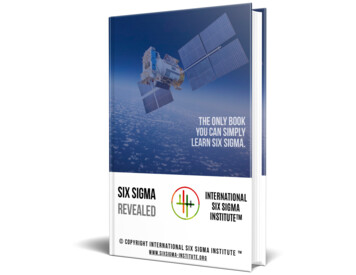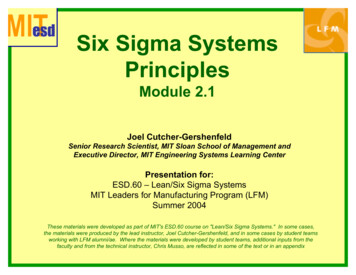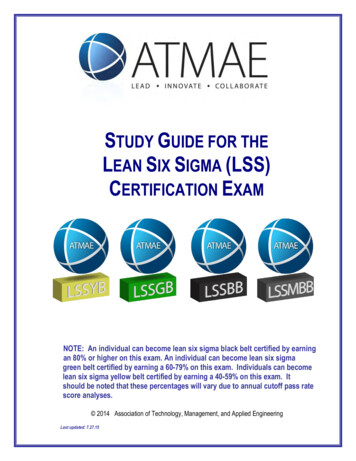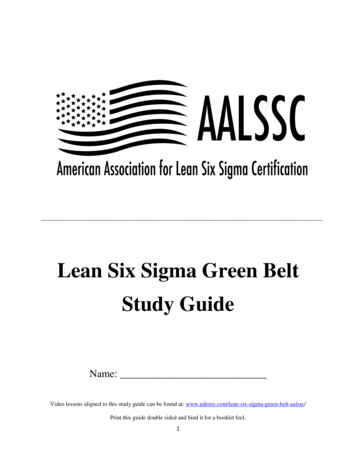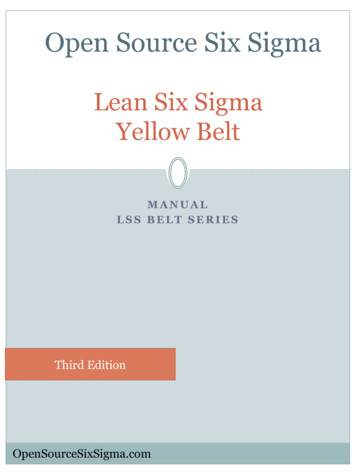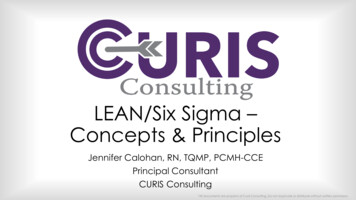
Transcription
LEAN/Six Sigma –Concepts & PrinciplesJennifer Calohan, RN, TQMP, PCMH-CCEPrincipal ConsultantCURIS Consulting*All documents are property of Curis Consulting. Do not duplicate or distribute without written permission.
LEAN Principles –What Does it Mean? The term LEAN transformation isused to characterize a companymoving from an “old way” ofthinking to “lean thinking”. LEAN is about creating the mostvalue for the customer whileminimizing waste. A LEAN approach is aboutunderstanding what’s really goingon, and improving the processes bywhich products and services arecreated and delivered. *All documents are property of Curis Consulting. Do not duplicate or distributewithout written permission.
LEAN is --- About “doing more withless”, but that means . Doing more productivework with less effort andwaste NOT about doing more workwith less resources!*All documents are property of Curis Consulting. Do not duplicate or distributewithout written permission.
Six Sigma is -- “Six Sigma is shorthand for a disciplinethat allows any business to design,improve and manage its processesso that they perform at their highestpossible levels. High levels of performance meanhigh volume, fast turnaround times,very few errors or defects and lowcost. Effective and efficient processesalso help to reduce staff turnoverand increase retention by eliminatingone of the main causes of highturnover – cumbersome andcomplex procedures and thcare/six-sigma-powerful-strategy-healthcare- providers/*All documents are property of Curis Consulting. Do not duplicate or distributewithout written permission.
LEAN SIX SIGMA LEAN SIX SIGMA*All documents are property of Curis Consulting. Do not duplicate or distributewithout written permission.
Striking the Balance*All documents are property of Curis Consulting. Do not duplicate or distributewithout written permission.
Key Terms/Tools Kaizen: “change for better” – model of continuous improvement Gemba: “real place” – the place where value is created Gemba Walk: walking through the Gemba to perform currentstate assessment VOC: Voice of the Customer 5-S: “organization” – sort, straighten, shine, standardize, sustain 5 Why’s – root cause analysis A3: a structured problem solving and continuous improvementapproach/tool PDSA: tool for process improvement to incrementally test andmeasure change DMAIC: quality improvement methodology*All documents are property of Curis Consulting. Do not duplicate or distributewithout written permission.
Kaizen –Part Philosophy Part Action Plan*All documents are property of Curis Consulting. Do not duplicate or distributewithout written permission.
Kaizen Model & Strategy Kaizen (Continuous Improvement)is a strategy where employees atall levels of the company worktogether proactively to achieveregular, incremental improvements Kaizen is about organizing events focused on improvingspecific areas within the company. These events involveteams of employees at all levels, with an especially strongemphasis on involving front line employees Kaizen works hand-in-hand with Standardized Work*All documents are property of Curis Consulting. Do not duplicate or distributewithout written permission.
8 Steps of the Gemba Walk1. Why? – Identify the Purpose forthe walk2. Why? – Be sure to understand theprocess to be observed3. When? – Identify a specifictime(s) to observe4. Where? – Be sure to observe in the area where thework is done and value is created5. Who/What? – Focus on observing processes and takenotice of the quality of the service(s) provided .inputs & outputs/interactions*All documents are property of Curis Consulting. Do not duplicate or distributewithout written permission.
8 Steps of the Gemba Walk6. How? – Take notice of how theprocess functions in the current state(separate people from process)7. What? – Observe and identify thegap between the “ideal” state andwhat is occurring in current state8. Why? – Identify opportunities forimprovement (with the end goalbeing: closure of the gap betweenideal & current state)*All documents are property of Curis Consulting. Do not duplicate or distributewithout written permission.
What the Gemba Walk IS & IS NOTGemba Walk IS to:ObserveUnderstandFocus on ProcessAsk QuestionsEngage PeopleLearnBe TransparentGemba Walk is NOT to:JudgePlace BlameFocus on PeopleMake AssumptionsDefine Specific ProblemLaunch intoImprovement Activities*All documents are property of Curis Consulting. Do not duplicate or distributewithout written permission.
LEAN 5S*All documents are property of Curis Consulting. Do not duplicate or distributewithout written permission.
A3 Tool*All documents are property of Curis Consulting. Do not duplicate or distributewithout written permission.
PDSA Cycles for Improvement The Plan-Do-Study-Act (PDSA) cycle is partof the Institute for Healthcare Improvement(IHI) Model for Improvement Simple yet powerful tool foraccelerating improvement. Essential to remember – if we can’tmeasure it – we can’t improve it! Always start with baseline measurements,decide on metrics for success, andremember to re-measure to determinecourse of lan-do-study-act-pdsa-cycle*All documents are property of Curis Consulting. Do not duplicate or distributewithout written permission.
PDSA Example*All documents are property of Curis Consulting. Do not duplicate or distributewithout written permission.
Give Your Quality ImprovementProgram Definition We all have our own idea of what Quality Improvement is(or should be) in our organization .but has it been definedand agreed upon? According to AAFP –“Quality improvement (QI) is a systematic, formal approach to the analysisof practice performance and efforts to improve ement/improvement/basics.html To ensure its success, your QI Program shouldbe defined through methodology, anassessment process and should incorporate anaccountability matrix.*All documents are property of Curis Consulting. Do not duplicate or distributewithout written permission.
*All documents are property of Curis Consulting. Do not duplicate or distributewithout written permission.
*All documents are property of Curis Consulting. Do not duplicate or distributewithout written permission.
QI Methodology - DMAIC*All documents are property of Curis Consulting. Do not duplicate or distributewithout written permission.
Step 1 - Define Define the Problem or Opportunity What do we see as the issue in need of improvement? It may be the problem– or it may be a symptom of an underlying problem. Declare it with a problemstatement. Define the Impact How severe is the issue? What is the impact on clinical, operational, financialor quality performance? What is the impact to our internal teams? What is theimpact to our patients/customers? Define the Target or Goal Declare your goal with a statement that is reflective of your problemstatement. Be certain that your goals are SMART (specific, measurable,achievable, relevant, timebound). Determine your Metrics for Success – what metrics will indicate success? Define the Process/Scope Determine the process to be improved, the high level scope and theappropriate resources to involve Define the Customer(s) Determine your customers and their needs, requirements, expectations Voice of the Customer*This step requires the team to have access to some baseline data. There will be a problemstatement developed and a charter created for the scope of the project/work.*All documents are property of Curis Consulting. Do not duplicate or distributewithout written permission.
Identify & Define the Customer We must define the customers of: The healthcare delivery system as a wholeEach process being targeted forimprovement We must identify each customer as: Internal CustomersExternal CustomersWe must incorporate the Voice of the Customer (VOC)into every process!!*All documents are property of Curis Consulting. Do not duplicate or distributewithout written permission.
Project Charter (Step 1 – Define)Project CharterSampleImpact/Business Case Why should you do this project/improvement work?What are the anticipated benefits of doing this work?Problem Statement What is the problem/issue/concernGoal What are the targets/goals associated with this work?Metrics What are the primary metrics to be used?What are the secondary metrics to be used?Scope of Work What processes are being included in this work?What processes are not being included in this work?Team Who is the executive sponsor?Who is the leader?Who are the team members?What are the roles and responsibilities associated with each team member relatedto the scope of work?Plan How will this project be conducted?When will this project be completed? REFER TO DMAIC STEPSCommunication When, where and how will the team meet?How will communication be facilitated?How often will updates be reported to leadership/exec sponsor?*All documents are property of Curis Consulting. Do not duplicate or distributewithout written permission.
Step 2 – Measure Measure the current state (process map) Measure the waste associated with theprocess Measure the performance related to theprocess Measure actual and potential barriers*This is your data collection step – once data is collected and documented,remember to continue to remeasure and refine your data throughout the process!*Update your charter once you have validated your baseline data!*All documents are property of Curis Consulting. Do not duplicate or distributewithout written permission.
If We Can’t Measure it – We Can’tImprove it! Essential to remember – if we can’tmeasure it – we can’t improve it! Always start with baseline measurements,decide on metrics for success, andremember to re-measure to determinecourse of action1. Establish plans to incrementally improve working toward future state.2. Implement strategies to improve – remeasuring along the way.3. Sustain success, reassess, continuously improve!*All documents are property of Curis Consulting. Do not duplicate or distributewithout written permission.
FMEA Tool – Failure Mode & Effects Analysis*All documents are property of Curis Consulting. Do not duplicate or distributewithout written permission.
Identifying Barriers – Potential & Actual*All documents are property of Curis Consulting. Do not duplicate or distributewithout written permission.
Step 3 – Analyze Analyze the problem/process Root Cause Analysis – 5 Why’s Analyze cause and effect May use Fishbone Diagram Analyze the data Analyze the waste and or value stream*Continue to document your progress, update your charter and remeasure as appropriate.*All documents are property of Curis Consulting. Do not duplicate or distributewithout written permission.
Step 3 –Root Cause Analysis & 5 Why’s*All documents are property of Curis Consulting. Do not duplicate or distributewithout written permission.
Benefits of the 5 Whys Help identify the root cause of a problem. Determine the relationship between different root causesof a problem. One of the simplest tools; easy to complete When Is 5 Whys Most Useful? When problems involve human factors or interactions. How to Complete the 5 Whys Write down the specific problem. Writing the issue helps youformalize the problem and describe it completely. It also helps ateam focus on the same problem. Ask Why the problem happens and write the answer down below the problem. If the answer you just provided doesn’t identify the rootcause of the problem that you wrote down in Step 1, askWhy again and write that answer down. Loop back to step 3 until the team is in agreement that theproblem’s root cause is identified. Again, this may take fewer ormore times than five Whys.*All documents are property of Curis Consulting. Do not duplicate or distributewithout written permission.
Step 4 - Improve Improve – correlates to the “Do” in the PDSAcycle. Improve process by addressing the RootCause that was detected in Step 3 –Analyze Phase. Improve by monitoring progress Improve by updating processes as progressis monitored and measured Improve by preparing a Control Plan forsustainability*All documents are property of Curis Consulting. Do not duplicate or distributewithout written permission.
Improve Do The Plan-Do-Study-Act (PDSA) cycle is partof the Institute for Healthcare Improvement(IHI) Model for Improvement Simple yet powerful tool foraccelerating improvement *By using the PDSA cycle toincrementally test change in aneffort to improve, we are able toapply pragmatic steps of ProcessImprovement toward reaching thestrategic level n-do-study-act-pdsa-cycle*All documents are property of Curis Consulting. Do not duplicate or distributewithout written permission.
Step 5 – Control Control by intentionally monitoring andmeasuring improvements Control by measuring Success according topredetermined metrics for success that wereoutlined in your project charter from Step 1 –Define Phase Control by developing sustainability plan forongoing future performance*All documents are property of Curis Consulting. Do not duplicate or distributewithout written permission.
Sustainability Through Accountability(RACI)*All documents are property of Curis Consulting. Do not duplicate or distributewithout written permission.
Sustainability Planning Ask the “W-W-W” questions – WHO will do WHAT by WHEN? WHO – What group or individual will have accountabilityfor ongoing progress/performance? WHAT – What metrics/process/forum will be used todemonstrate/measure/report on the performance movingforward? WHEN – When or how often will the performance bereassessed, remeasured and reported out?*All documents are property of Curis Co
Six Sigma is --- “Six Sigma is shorthand for a discipline that allows any business to design, improve and manage its processes so that they perform at their highest possible levels. High levels of performance mean high volume, fast turnaround times, very few errors or defects and low cost. Effective and efficient processes also help to reduce staff turnover and increase retention by .


